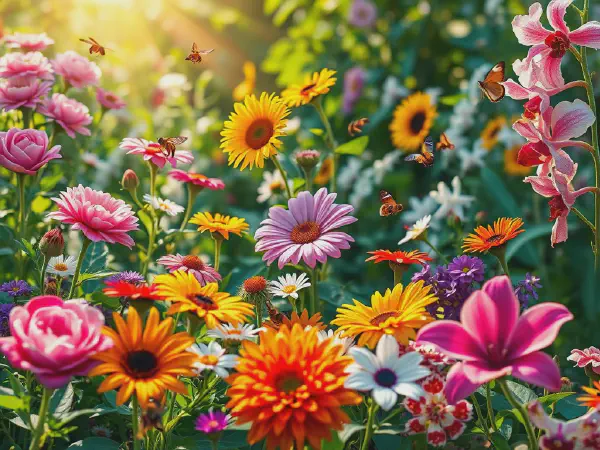Explore the Different Types of Flowers in Nature

A Comprehensive Guide to Types of Flowers
Flowers are a beautiful and diverse component of the plant kingdom, with thousands of different types representing various families, shapes, and colors. Understanding the different types of flowers can enhance gardening experiences, improve landscape design, and deepen appreciation for nature's beauty. In this article, we explore the various types of flowers, their characteristics, and their uses in our lives.
The types of flowers can generally be categorized into several groups based on their life cycles, habitats, and families. Each type has its unique attributes, care requirements, and uses that serve both aesthetic and practical purposes. From vibrant annuals to resilient perennials, the world of flowers is rich and varied.
This article will also delve into the families and structures of flowers, discussing popular families such as Rosaceae, Asteraceae, and Orchidaceae. We will examine how these families contribute to the diversity of flower types, illustrating their significance in gardening and horticulture.
Moreover, we will explore the uses of different flower types across various domains including ornamental gardening, culinary applications, medicinal benefits, and cultural symbolism. Flowers not only beautify our surroundings—they also enrich our lifestyles in multiple ways.
Finally, we will provide insights into seasonal flowers, highlighting blooms that thrive in different weather conditions and environments. Understanding how to nurture various flower types through their respective seasons will help any gardener create a vibrant and colorful garden year-round.
Common Flower Types
Annual flowers complete their life cycle within a single growing season, meaning they sprout, blossom, and die in less than a year. Popular examples of annual flowers include petunias, marigolds, and zinnias. These flowers are often favored for their abundant blooms and vibrant colors, making them perfect for seasonal gardens and containers.
Perennial flowers, on the other hand, last for multiple growing seasons. They can survive winter and re-emerge in the spring. To ensure longevity, these flowers often require proper care, including the right soil and pruning. Notable examples of perennial flowers include peonies, hostas, and lavender, which can provide enduring beauty in gardens.
Biennial flowers take two years to complete their life cycle, typically growing foliage in the first year and flowering in the second. This growth habit can be seen in plants like foxgloves and hollyhocks. Their unique growth cycle allows for seasons of anticipation and more extended periods of growth, adding depth to garden planning.
Wildflowers are native plants that grow in natural habitats without cultivation. They exhibit diverse characteristics and adaptations suited for their local environments. Wildflowers are particularly important for biodiversity, attracting pollinators. Examples include poppies, daisies, and bluebells, which offer natural beauty while supporting ecosystems.
Exotic flowers consist of species that are not commonly found in specific regions and can provide unique visual interest. Examples of exotic flowers include the bird of paradise, orchids, and proteas. These flowers typically exhibit unusual shapes and vibrant colors, adding a touch of intrigue and uniqueness to any floral arrangement or garden.
Flower Families and Structures
The Rosaceae family is one of the most well-known flower families, encompassing popular flowers like roses, strawberries, and peonies. Roses are particularly prized for their beauty and fragrance, with numerous varieties available, each exhibiting different colors and sizes. This family plays a crucial role in ornamental horticulture and gardening.
Another prominent family is the Asteraceae family, comprising flowers like daisies and sunflowers. Known for their distinctive flower head structure, Asteraceae family members are essential in gardens and landscapes. Sunflowers, for example, bring cheer and brightness while attracting pollinators.
Orchidaceae is renowned for its complex and diverse orchid species. Orchids are characterized by their unique floral structures and intricate patterns, making them highly coveted among flower enthusiasts. With thousands of species, the orchid family showcases an extraordinary variety of colors, shapes, and sizes.
The Liliaceae family includes well-known flowers like lilies and tulips. Lilies symbolize purity and refined beauty, while tulips are treasured for their vibrant colors and unique shape. Both families require specific care, usually thriving in nutrient-rich soil and plenty of sunlight.
Finally, the Fabaceae family, commonly known as the legume family, includes flowers such as sweet peas and lupines. Many members of this family not only offer aesthetic appeal but also play a role in nitrogen fixation in soil, which benefits the health of gardens and ecosystems.
Uses of Different Flower Types
Ornamental flowers serve as visual enhancements in gardens and landscapes. Their beauty can transform outdoor spaces, providing color and fragrance that enhance the atmosphere. Popular ornamental flowers include geraniums, petunias, and marigolds, which brighten up patios, flower beds, and borders.
Edible flowers, such as nasturtiums, violets, and calendula, add color and flavor to dishes. They can be used in salads, desserts, or as garnishes, providing not only aesthetic appeal but also nutritional benefits. Many edible flowers have unique tastes that can elevate culinary experiences.
Medicinal flowers have been utilized in traditional medicine for centuries. Flowers like chamomile and lavender are renowned for their calming properties, while others like echinacea are believed to boost the immune system. The healing properties of these flowers continue to play a role in herbal remedies today.
Flowers in symbolism often carry significant meanings across various cultures. For example, red roses are synonymous with love and romance, while white lilies represent purity and renewal. Understanding flower symbolism can add depth and meaning to gift-giving and decor.
Flowers are widely used in decoration for events such as weddings, anniversaries, and parties. Flower arrangements can bring life to any occasion, with skilled florists creating displays that evoke emotions and set the ambiance. Popular choices for decoration include roses, hydrangeas, and orchids.
Seasonal Flowers
Spring flowers herald the end of winter and are celebrated for their vibrant colors and scents. Popular spring flowers include daffodils, tulips, and hyacinths. They typically bloom from March to May and are essential for reawakening gardens after the cold months.
Summer flowers such as sunflowers, zinnias, and dahlias thrive in heat and full sun. They bring vibrant colors and a lush appearance to gardens during the warmer months. These flowers often require consistent watering and nutrients to flourish in the heat.
In autumn, flowers like chrysanthemums, asters, and marigolds come into prominence, displaying rich, warm colors. These flowers capture the essence of the season and provide visual interest as gardens transition to winter. They often continue blooming until the first frost.
Winter flowers, while fewer in number, showcase resilience in cold weather. Examples include hellebores, winter jasmine, and camellias, which can bloom even in the chill of winter. They provide subtle beauty and color when much of the garden is dormant.
Festive flowers like poinsettias and amaryllis are commonly associated with holidays such as Christmas and New Year. These seasonal flowers add cheer to decorations and celebrations, embodying the spirit of festivities.
Flower Care and Cultivation
Understanding soil types is crucial for successful flower cultivation. Different flowers thrive in specific soil conditions, such as well-draining sandy loam for succulents or richer, moisture-retentive soils for hydrangeas. Conducting a soil test can guide proper amendments for optimal flower health.
Watering schedules play a key role in maintaining healthy flowers. Regular, adequate watering is essential, but overwatering can lead to root rot. It's important to consider the specific needs of each flower type, adjusting frequency based on weather conditions and growth stages.
Pest control is vital for protecting flowers from damaging insects and diseases. Natural remedies, such as neem oil or insecticidal soaps, can be used alongside preventive measures like companion planting to minimize pest infestations.
Pruning techniques promote healthy growth and blooming. Routine deadheading and trimming can encourage new growth and maintain the shape of flowering plants. Knowing when and how to prune specific flowers enhances their overall aesthetic and health.
Fertilization methods, including organic and synthetic options, provide essential nutrients for flowering plants. Understanding the nutritional needs of different flower types can maximize growth and blooming potential, leading to more vibrant and healthy flowers.
